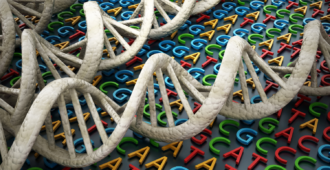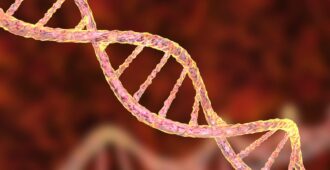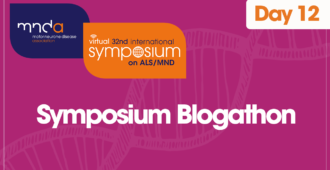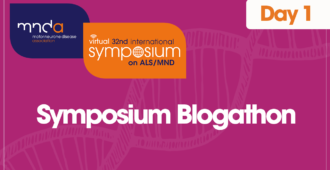This week sees the start of the 30th International Symposium on ALS/MND in Perth, Australia. The Symposium brings together the brightest minds from the MND research and healthcare communities. With 110 oral presentations, and over 420 posters, the Symposium is an opportunity for around 1,000 researchers and healthcare professionals to share new understanding of the disease, and is the premier event in the MND research calendar for discussion on the latest advances in research and clinical management.
 Before the Symposium, the Research Information team invited two early career researchers, who are both presenting a poster at this year’s event, into our offices to talk about their work and why the Symposium is important to them.
Before the Symposium, the Research Information team invited two early career researchers, who are both presenting a poster at this year’s event, into our offices to talk about their work and why the Symposium is important to them.
We thought we would share this with you, and this is the first of two blog articles highlighting MND researchers of the future – introducing Tobias Moll.
About Tobias
Tobias enjoyed the hobbies of ballet dancing and playing the piano and violin as he grew up, but his interest in motor neurone disease came about following a 20-week research project that he undertook as part of his master’s degree at the University of Sheffield, which investigated the role of DNA damage in MND. Finding the science underpinning this disease fascinating, Tobias was determined to further his understanding of it and, after completing his masters, began a PhD meaning his hobbies had to give way to some serious study.
A PhD, or Doctor of Philosophy, is a university degree and the first major step on the road to becoming a researcher. It takes around 3-4 years to complete, researching a given topic with the aim of contributing novel findings to further knowledge and understanding. Tobias will follow his PhD with a postdoc appointment in the field of MND research, with the long term aim of receiving a fellowship to start his own lab group within an academic research institute. This blog article will look at Tobias’ work as a PhD student, which he is presenting at the Symposium and focuses on a new MND gene called GLT8D1 (or glycosyltransferase 8 domain containing 1, to give it its full name).
About Tobias’ research
The function of this gene remains unknown, but it has been found to be mutated in a group of patients with MND. The primary aim of Tobias’ research has been piecing together a mechanism linking GLT8D1 mutations to the loss of motor neurons in these patients. To gain some insight into the function of the gene, it was first necessary to find out where the GLT8D1 protein resides in human cells. This was found to be in an area of the cell called the Golgi network. Next, the mutated GLT8D1 gene was introduced to human cells in a dish to see how it affected their survival and to observe toxic effects, highlighting the severity of mutations and the importance of this gene to cell survival. In a zebrafish model, the mutated gene was seen to reduce the ability of the fish to move, a characteristic of MND, and suggests that GLT8D1 is important for motor function.
GLT8D1 is from a family of proteins called glycosyltransferases whose function is to transport sugars. It was found that GLT8D1 interacts with a sugar called galactose and the GLT8D1 mutations affect its ability to interact properly. Other members of the glycosyltransferase family are involved in making molecules in the cell called gangliosides. Gangliosides are important for sending messages between cells but also for maintaining the health of neurons, and Tobias has discovered that GLT8D1 mutations directly influence the expression of gangliosides in human cells, providing evidence that these are potential therapeutic targets.

Picture B – human cells with a GLT8D1 mutation
The blue dots represent individual cells, and the green shows gangliosides. In picture B there is less green, therefore reduced gangliosides, in the cells with a GLT8D1 mutation
How might this help people with MND in the future?
Tobias’ work has looked at new genetic causes of MND, and this could lead to the discovery of new disease mechanisms and the identification of novel therapeutic targets. As these genetic causes are studied in more detail, it will further our understanding of the genetic architecture of MND and identify important links with disease pathways. This information provides the foundation for early phase clinical trials.
The importance of the Symposium
I asked Tobias how presenting his work in Perth might help with his research. He said, “Presenting my work in Perth will provide the perfect networking opportunity, particularly as the different location means many research groups who did not attend last years’ Symposium in Glasgow will be attending this one. The coming together of individuals from various scientific disciplines enables you to ask questions and obtain answers that help to drive your research forward.”
Hope for the future
When asked how hopeful he was about finding a new treatment, or even a cure, for MND Tobias said, “I am extremely hopeful about finding a cure for MND. The international collaborative efforts mean that our knowledge and understanding of MND is progressing faster than ever before. On top of this, technology is advancing at an incredible rate and we are already seeing overwhelming developments, particularly in the field of gene therapy. Given the complexity of MND, the fight against it really requires a collaborative effort and I am inspired by the combined efforts across the world from patients and carers through to clinicians, researchers and charities. I am honoured to work alongside so many people that all share the common goal of curing MND.”
We would like to thank Tobias for taking the time to come to the Association to talk about his work and for providing the content for this blog article. We wish him every success in Perth and for the future.






